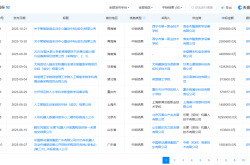Online Recruitment Industry Enters the 'Truman Show' Era
![]() 03/17 2025
03/17 2025
![]() 443
443

Online recruitment platforms have consistently aimed to enhance the precision of supply-demand matching, from which they derive value-added services for both parties.
On the evening of March 11, Beijing time, Kanzhun Technology Co., Ltd. (hereinafter referred to as "BOSS Zhipin") released its financial report for the fourth quarter and full year of 2024. The report revealed that BOSS Zhipin's revenue for the full year of 2024 amounted to RMB 7.356 billion, marking a 23.6% year-on-year increase. Revenue for the fourth quarter stood at RMB 1.824 billion, up 15.4% year-on-year.
Within the twelve months ending December 31, 2024, the number of paid enterprise customers reached 6.1 million, a 17.3% year-on-year increase. Net profit was RMB 1.567 billion, representing a 42.6% year-on-year growth.
Behind these robust figures lie intricate details. According to last year's statistics from the National Bureau of Statistics, the urban unemployment rate for 16-24-year-old laborers (excluding students) was 15.7% in December, contrasting sharply with the financial report data. Algorithms have indeed accelerated resume submissions, but the fundamental issue of job scarcity persists.
This 'pseudo-efficiency' highlights a critical flaw in the traffic economy: When the annual MAU exceeds 53 million, each additional active user intensifies internal competition within the system. It resembles a crowded subway car during rush hour; more passengers do not create more space but only increase the risk of overcrowding.
Indubitably, the efficiency narrative of the online recruitment industry is encountering the challenge of diminishing marginal utility.
01. A Platform that is Better but also Heavier
Online recruitment platforms operate on an alternative 'audience commodity theory': user activity, encompassing the quantity, fluidity, and quality of the resume database, serves as leverage to attract B-end payments and renewals. Therefore, monthly active users (MAU) are a key indicator of BOSS Zhipin's competitiveness.
Last year, BOSS Zhipin's average monthly active users for the full year reached 53 million, a 25.3% year-on-year increase. According to 2024 statistics from Yuehu Data, in July 2024, the monthly active users of Zhaopin.com, 51job.com, and Liepin.com were 25.34 million, 15.59 million, and 7.42 million, respectively. In other words, BOSS Zhipin's monthly active users surpassed the combined total of these three other recruitment platforms.
It can be said that over the past few years, BOSS Zhipin has captured the vast majority of the domestic recruitment market in this sector.
Although the monthly active users in the fourth quarter fell to 52.7 million, slightly lower than market expectations, considering the impact of this year's Spring Festival, it is normal for many users' job-seeking intentions to diminish. However, this change in user activity is a unified characteristic of the industry. Combined with third-party data, the expansion speed of BOSS Zhipin's user base has consistently been higher than that of its peers.
Moreover, 2024 witnessed large-scale technological iterations and industrial upgrades, accompanied by an increased demand for new professional talents. According to iResearch Consulting, from 2021 to 2025, the talent gap for occupations such as internet marketers, corporate compliance specialists, and AI trainers is expected to reach nearly 120 million. The growing popularity of large model and AI-related positions benefits platforms like BOSS Zhipin, which primarily serve internet companies and SMEs.
Specifically, last year's revenue from online recruitment services for enterprise customers was RMB 7.27 billion, a 23.4% year-on-year increase. Other services, primarily comprising paid value-added services for job seekers, generated revenue of RMB 85.65 million, a 36.1% year-on-year increase.
Among them, ToB revenue remains the primary source, with revenue growth driven by both user growth and increased user engagement. The financial report indicated that as of December 31, 2024, the total number of paid enterprise customers was 6.1 million, a 17.3% year-on-year increase, with a net increase of 900,000.
It's worth noting that BOSS Zhipin's fee-based services for both ends have been humorously referred to as a game-like pay-to-win model. While there is logically no issue with value-added services focusing on paying for a better experience, the challenge lies in setting the amount and items at a balance point that does not affect user experience and does not exceed consumption expectations.

Currently, the value-added services provided by BOSS Zhipin include Zhidou, competitive job postings, Niuren Direct Pass, Urgent Hiring Direct Pass, Niuren Bomb Pro, Search Chat Pass, SMS Notifications, Direct Phone Calls, Chat Refuel Pack, Batch Follow-Up Chats, Search Top Card, Exposure Refresh Card, Background Check, VIP Account, VIP Privilege Pack, Niuren VIP, Resume Refresh, Competitiveness Analyzer, Direct Hire Discount Package, among others.
The fee structure for the B-end is particularly complex, with advanced operations such as searching resumes, mass messaging, and top job postings requiring payment. Limited free benefits are followed by step-by-step thresholds, each requiring top-ups. Many enterprise users have expressed dissatisfaction with BOSS Zhipin's disorderly price increases and fees on platforms such as Heimao and Xiaohongshu.
When a platform's monetization approach is singular, it tends to seek internal growth by increasing the proportion of fees, thereby making the entire business chain heavier. Industry leaders may indeed have the confidence to leave consumers with 'no other choice,' but if the balance between free and paid benefits is excessively tilted, it will inevitably erode user experience and prompt users to consider migration.
To avoid a stagnant business model, it is necessary to either explore more demand and find incremental markets externally or continue to optimize services so that users can tangibly feel that their money is well-spent.
02. A Logically Torn Blue-Collar Market
On the surface, the 38% revenue share from the blue-collar sector conceals certain contradictions: In the current context of labor supply and demand, the platform cannot break through the cyclical fluctuations in manufacturing labor demand nor resist the loot of user attention by new traffic entry points (such as short videos).
For the platform, the strategic shift towards the blue-collar market is indeed a clever solution to cope with the contraction of white-collar positions, but the limitations of internet thinking in the field of labor allocation have not improved.
Most intuitively, manufacturing factories do not need ineffective bombardments of massive resumes but rather stable and predictable labor supply. Workers do not pursue 'high-paying opportunities' pushed by algorithms but rather transparent and credible rights and benefits. These essential demands on both the supply and demand sides fundamentally conflict with the platform's 'traffic-to-monetization' model.
The result is that the industry ecosystem is quietly changing. Traditional recruitment platforms once built moats through information monopolies, but now this monopoly is gradually being dismantled by three forces:
Short video platforms (such as Kuaipin) reconstruct trust chains through content ecosystems, transforming recruitment into an immersive experience rather than a cold exchange of text information.
Content communities (like Xiaohongshu) where job seekers spontaneously share blacklist enterprises and interview tips, forming a decentralized information network.
Regulatory forces' emphasis on the 'light review' model forces platforms to recalibrate the balance between commercial interests and social responsibility.
These changes not only shake the foundation of the traffic business but also signify the reconstruction of the industry's value chain. Once the identity of an information intermediary is no longer scarce, platforms need to rethink their niche in human resource allocation.
In a sense, BOSS Zhipin's prized 53 million monthly active users may, in this dimension, become a negative asset for transformation. This is akin to traditional department stores facing the impact of e-commerce, where the larger the offline network, the more cumbersome it becomes.
As enterprises discover that real-time interaction through live streaming can effectively reach blue-collar groups, their willingness to pay a premium for online recruitment services will gradually decrease. This substitutive competition is not merely about market share but about disrupting the entire recruitment industry's value distribution system. To maintain user growth, BOSS Zhipin has had to build trust mechanisms through certification systems such as 'Conch Preferred.'
This heavy-operation solution essentially shifts the review responsibility that should be borne by the platform onto enterprises, raising the entry threshold while also screening out a large number of small and medium-sized employers with limited payment capabilities. Although strategic contraction has stabilized financial report data in the short term, it has resulted in the platform losing flexibility during manufacturing off-seasons, handing over massive and fragmented labor demand to more flexible ground promotion agencies and labor dispatch companies.
When a large number of job seekers discover discrepancies between recommended positions and real work experiences, cracks in the traffic conversion funnel become irreparable. The cumulative effect of this trust depletion is far more destructive than fluctuations in quarterly MAU data.

Of course, this is not just a problem for BOSS Zhipin but reflects the collective anxiety of the entire online recruitment industry. As traffic dividends peak, technological marginal benefits diminish, and employment uncertainty increases, business models that rely solely on user growth have reached their limits. While platforms attempt to find a second curve by increasing investment in AI and tapping into the lower-tier market, they fail to realize that the digital transformation of the labor market has already moved beyond the simple stage of person-position matching into a new cycle focused on demand-side reconstruction.
Service providers that can deeply intervene in the employment process and provide flexible human resource solutions are emerging, while traditional platforms still stuck in the traffic pool are likely to become the backdrop for changes in the labor market in the digital era.
03. Written at the End
When Zhao Peng founded BOSS Zhipin in 2014, amidst the rise of the mobile internet wave, he creatively proposed the 'direct chat' model, and BOSS Zhipin has since become the largest recruitment platform in China. For most of the time so far, investors have viewed BOSS Zhipin as having a more advanced business model than its peers, thus earning a growth premium.
But looking back from 2025, BOSS Zhipin's problem also lies in its business model: Should it become the 'water, electricity, and gas' infrastructure of the human resource market or remain a 'middleman' in traffic reselling?
Choosing the former may mean enduring a rational return on gross margin and the need to build an ecosystem encompassing skills training, rights and benefits protection, and career development. Choosing the latter would mean facing the continued squeeze of dimensionality reduction strikes from platforms like Douyin Kuaipin and policy risks.
The 'miracle' of cost reduction in the financial report, where the proportion of marketing expenses in 2024 fell to 28%, the lowest since the company's listing, also reflects some strategic hesitation: When a company attempts to play the dual roles of an efficiency revolutionary and a profit extractor simultaneously, it often can only maintain growth by compressing service costs.
This tightrope-walking balance may please short-term investors but fails to answer more fundamental questions: When 'maintaining growth' and 'preserving profits' become the supreme principles, how much courage does the platform have to break the existing interest structure?
*The lead image and images in the text are sourced from the internet.






